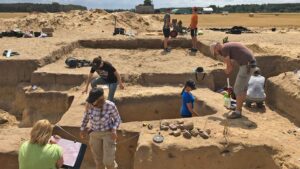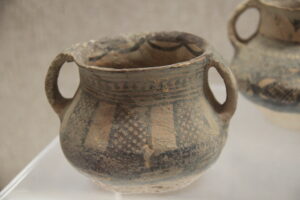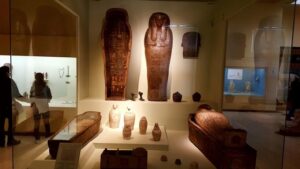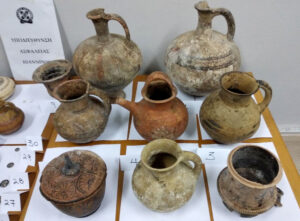WHAT IS ARCHAEOLOGY?
Archaeology is the scientific study of past human cultures and societies through the examination and interpretation of artifacts, structures, and other physical remains. It aims to uncover and understand the lives, behaviors, beliefs, and practices of ancient peoples by analyzing the material traces they left behind. Archaeologists use a combination of fieldwork, excavation, laboratory analysis, and historical research to reconstruct and interpret aspects of human history that are not always well-documented in written records. The field of archaeology contributes to our understanding of how civilizations have evolved over time, shedding light on various aspects of human life, such as technology, art, social organization, economic systems, and more.
WHAT IS THE IMPORTANCE OF SYMBOLS IN ARCHAEOLOGY? 
Symbols hold significant importance in archaeology as they provide valuable insights into the beliefs, values, communication systems, and cultural practices of past societies. Here are some key reasons why symbols are crucial in archaeology:
1. Cultural Expression: Symbols are a form of cultural expression and communication. They can represent religious beliefs, social hierarchies, political ideologies, and other aspects of a society’s identity.
2. Interpretation of Artifacts: Many artifacts from the past are adorned with symbols, such as pottery, jewelry, and textiles. Analyzing these symbols helps archaeologists understand the meanings and purposes behind these artifacts.
3. Ritual and Religion: Symbols often play a central role in religious and ritualistic practices. By studying symbols found in religious sites, temples, and burial grounds, archaeologists can gain insights into the spiritual beliefs of ancient cultures.
4. Social Organization: Symbols can reflect social hierarchies and group affiliations. For example, certain symbols might be associated with specific classes, professions, or tribal affiliations.
5. Chronological Dating: Symbols on artifacts can sometimes be used to help date objects. Over time, symbols may evolve or change, and their presence or absence can provide clues to the temporal context of the artifact.
6. Trade and Cultural Exchange: Symbols found on artifacts can indicate connections between different cultures and regions through trade and cultural exchange. Shared symbols might suggest interactions and influences between societies.
7. Written Language Precursors: Some symbols represent early forms of written language or proto-writing systems. Studying these symbols can provide insights into the development of human writing and communication.
8. Identity and Ethnicity: Symbols can contribute to our understanding of ethnic identities and group affiliations. They help archaeologists explore how different societies defined themselves in relation to others.
9. Cognitive Processes: Symbols can provide insights into the cognitive processes of ancient people. Understanding how symbols were created, used, and interpreted sheds light on human thought and expression.
10. Continuity and Change: Symbols can show how cultural practices and beliefs changed or persisted over time. Studying shifts in symbols can reveal societal transformations.
In essence, symbols are like windows into the minds of people from the past, enabling archaeologists to piece together the cultural, social, and ideological dimensions of ancient civilizations that may not be fully documented in historical texts.
HOW DO ARCHAEOLOGIST DETERMINE THE AGE OF ANY FINDING SUCH AS POTTERY, ETC.
Archaeologists use various methods to determine the age of archaeological findings, including pottery and other artifacts. Here are some common techniques:
1. Stratigraphy: Stratigraphy involves analyzing the layers of sediment or soil in which artifacts are found. Lower layers are usually older than upper layers due to the principle of superposition. This helps establish a relative chronological sequence.
2. Radiocarbon Dating: Radiocarbon dating, also known as carbon-14 dating, is a widely used method for dating organic materials like wood, bone, and charcoal. It relies on the decay of carbon-14 isotopes in the material, providing an estimate of its age.
3. Dendrochronology: Dendrochronology, or tree-ring dating, is used for dating wooden artifacts and structures. By comparing the patterns of growth rings in wood samples with a master chronology, archaeologists can determine the exact calendar year when the tree was cut.
4. Thermoluminescence Dating: Thermoluminescence dating is used for dating objects that were heated in the past, such as pottery and certain minerals. These materials accumulate trapped electrons over time, and when heated, they emit light. Measuring this light can provide an estimate of when the material was last heated.
5. Optically Stimulated Luminescence (OSL): OSL is similar to thermoluminescence but is used for dating minerals like quartz and feldspar. These minerals trap electrons when exposed to sunlight or heat, and the trapped electrons can be released when exposed to light in the lab. Measuring the emitted light helps estimate the time since the last exposure to sunlight or heat.
6. Potassium-Argon Dating: This method is used for dating volcanic rocks and minerals. It relies on the decay of potassium-40 isotopes into argon-40, providing a way to determine the age of the rocks or minerals.
7. Historical Records and Cross-Dating: In some cases, historical records and inscriptions can help date artifacts and structures. Cross-dating involves comparing artifacts found at one site with those from another site with established dates.
8. Seriation: Seriation involves arranging artifacts in chronological order based on their styles and design changes. This relative dating technique is particularly useful for dating ceramics and other objects with evolving decorative styles.
It’s important to note that dating methods can have limitations and uncertainties, and different methods are often used in combination to corroborate results. Additionally, some methods are better suited for specific time periods or materials. Archaeologists carefully consider the context, material, and available dating techniques to arrive at accurate estimates of the age of archaeological findings.
WHAT ARE THE VARIOUS FUNCTIONS OF ARCHAEOLOGY?
rchaeology serves multiple functions and plays various roles in understanding and preserving our past. Here are some of the key functions of archaeology:
1. Reconstruction of History and Culture: Archaeology helps reconstruct the history, lifeways, cultural practices, and social structures of past civilizations. By studying artifacts, architecture, and other remains, archaeologists can piece together a more comprehensive understanding of how people lived in different time periods.
2. Preservation and Conservation: Archaeologists work to preserve and conserve archaeological sites and artifacts for future generations. This involves careful excavation techniques, documentation, and efforts to protect sites from natural elements, vandalism, and development.
3. Dating and Chronology: Archaeology provides dating methods that help establish the chronological sequence of events and developments in human history. These dating techniques contribute to constructing accurate timelines of the past.
4. Understanding Technological Evolution: Archaeological findings shed light on the technological advancements of ancient societies. By studying tools, implements, and materials, archaeologists can track the evolution of technologies over time.
5. Insights into Social Organization: Archaeology helps unravel the social structures, hierarchies, and organizational systems of past societies. Analysis of settlements, burials, and artifacts provides clues about class distinctions, leadership, and societal roles.
6. Exploration of Trade and Interaction: The study of trade routes, trade goods, and imported materials provides insights into ancient economic systems and cultural interactions between different regions and societies.
7. Examination of Cultural Change and Continuity: Archaeology allows us to trace cultural changes and continuities over time. By comparing artifacts and structures from different periods, archaeologists can identify shifts in cultural practices and traditions.
8. Insights into Ideology and Religion: Archaeology offers a window into the religious beliefs, rituals, and ideologies of past civilizations. Temples, religious artifacts, and sacred sites provide evidence of spiritual practices.
9. Environmental and Landscape Studies: Archaeological evidence can contribute to understanding how past societies interacted with and adapted to their environments. It provides insights into agriculture, resource use, and ecological changes.
10. Cultural Heritage and Identity: Archaeology plays a role in preserving cultural heritage and identity. It contributes to a sense of national and global identity by highlighting shared human history and the diversity of cultures.
11. Education and Public Awareness: Archaeology educates the public about the past and fosters an appreciation for history and heritage. Museums, exhibitions, and educational programs showcase archaeological discoveries and their significance.
12. Legal and Ethical Considerations: Archaeology also involves legal and ethical considerations, as some archaeological sites and artifacts might have cultural or spiritual significance to contemporary communities. Collaboration and respect for indigenous perspectives are crucial.
In essence, archaeology is a multidisciplinary field that plays a pivotal role in unraveling the mysteries of the past, preserving cultural heritage, and contributing to our understanding of human development and civilization.
HOW DO ARCHAEOLOGISTS COLLECT THE DATA?
Archaeologists collect data through a systematic process that involves fieldwork, excavation, documentation, and analysis. Here’s how they collect data, summarized in phrases:
- Site Selection: Identifying potential archaeological sites based on historical records, surveys, and remote sensing techniques.
- Surveying: Walking across landscapes to visually identify surface artifacts and features.
- Excavation Planning: Creating detailed excavation plans, including grids and recording methods.
- Excavation: Carefully removing layers of soil and sediment to uncover artifacts and structures.
- Stratigraphy: Recording the sequence and context of different soil layers.
- Mapping: Creating accurate maps of excavation areas and features.
- Photography: Documenting artifacts, structures, and excavation process through photography.
- Artifact Collection: Carefully recovering artifacts, pottery, tools, bones, etc., and labeling their positions.
- Recording: Documenting the location, context, and characteristics of each find.
- Lab Analysis: Cleaning, conserving, and analyzing artifacts in a controlled laboratory setting.
- Radiocarbon Dating: Using carbon-14 dating to estimate the age of organic materials.
- Dendrochronology: Analyzing tree-ring patterns in wood for dating.
- Artifact Typology: Categorizing artifacts based on type, style, and function.
- Technological Analysis: Understanding manufacturing methods and tool use.
- Functional Analysis: Determining how artifacts were used in daily life.
- Contextual Analysis: Interpreting artifacts within their cultural and historical context.
- Mapping Features: Mapping structures, walls, and other features within the site.
- Geophysical Surveys: Using techniques like ground-penetrating radar to detect subsurface features.
- Data Integration: Combining data from different sources for comprehensive analysis.
- Report Writing: Compiling findings, interpretations, and conclusions into detailed reports.
- Publication: Sharing results through academic journals, books, and presentations.
- Public Engagement: Communicating findings to the public through exhibits and outreach.
- Ethical Considerations: Respecting indigenous perspectives and local communities’ input.
- Legal Compliance: Adhering to national and international laws governing cultural heritage.
- Preservation: Ensuring proper conservation and storage of artifacts for future study.
Archaeological data collection involves meticulous attention to detail, interdisciplinary collaboration, and adherence to ethical standards to ensure accurate interpretation of the past.
